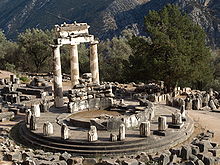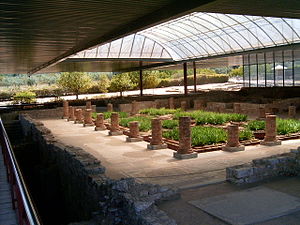- Classical architecture
-
Classical architecture is a mode of architecture employing vocabulary derived in part from the Greek and Roman architecture of classical antiquity, enriched by classicizing architectural practice in Europe since the Renaissance. Classical architecture has inspired many more recent architects and has led to revivals such as neoclassical architecture from the mid-18th century and the Greek Revival of the 19th century. After a brief period of eclecticism, the classical style reigned again from the late 19th century until the second world war, though it continues to inform many architects to this day.
The term,"Classical Architecture", also applies to any mode of architecture that has evolved to a highly refined state, such as Classical Chinese Architecture, or Classical Mayan Architecture. It can also refer to any architecture that employs Classical Aesthetic Philosophy.
Contents
Archaeological use
Classical architecture can be divided into:
- Greek architecture before Alexander the Great
- Hellenistic architecture
- Roman architecture
Only Greek architecture in the time before Alexander (who died in 323 BC) carries an authentic, ethnic designation. The ancient Greeks were notoriously dismissive of barbaroi – those who spoke Greek non-natively or not at all. The incredible conquests of Alexander and the subsequent application of a veneer of Greek city states to a base of Egyptian, Semitic, and Iranian populations produced an important change. Though speaking Greek remained the touchstone of whether one was a member of civilized culture or not, the ethnic diversification of the Hellenistic world is clear. The formal elements of classical Greek architecture were applied to temples for gods never worshipped in Greece.
The Romans can be seen as the latest Hellenistic empire. Pre-imperial architecture is more or less Etruscan with some Greek elements. By the time the Romans conquered mainland Greece in the 2nd century BC they were importing Greek craftsmen to build major public buildings. The term Roman Art and Roman Architecture has no ethnic meaning relating to Italic Romans. Most art historians assume that it has the ethnic meaning of "Greek-speaking slave" or "Greek-speaking free laborer," in fact.
Architectural use
Most of the styles originating in post-renaissance Europe can be described as classical architecture. This broad use of the term is employed by Sir John Summerson in The Classical Language of Architecture.
The "elements" of classical architecture have been applied in radically different architectural contexts than those for which they were developed. The classical orders – Doric, Ionic, and Corinthian – have meaning in the stylistic history of 5th century BC Greece, shifting to the developments in 1st century AD Gaul, with the styles revived over and over again since then.
Petrification
In the grammar of architecture, the word petrification is often used when discussing the development of sacred structures, such as temples, mainly with reference to developments in the Greek world. During the Archaic (please see Archaic Greece) and early Classical periods (about the 6th and early 5th centuries BCE), the architectural forms of the earliest temples had solidified and the Doric (see Classical order) emerged as the predominant element. A widely accepted theory in classical studies is that the earliest temple structures were of wood and the great forms, or elements of architectural style, were codified and rather permanent by the time we see the Archaic emergent and established. It was during this period, at different times and places in the Greek world, that the use of dressed and polished stone replaced the wood in these early temples, but the forms and shapes of the old wooden styles were retained, just as if the wooden structures had turned to stone, thus the designation petrification for this process.
This careful preservation of the primitive wooden appearance in the stone fabric of the newer buildings was scrupulously observed and this suggests that it may have been dictated by religion rather than aesthetics, although the exact reasons are now lost in the mists of antiquity. And not everyone within the great reach of Mediterranean civilization made this transition. The Etruscans in Italy were, from their earliest period, greatly influenced by their contact with Greek culture and religion, but they retained their wooden temples (with some exceptions) until their culture was completely absorbed into the Roman world, with the great wooden Temple of Jupiter on the Capitol in Rome itself being a good example. Nor was it the lack of knowledge of stone working on their part that prevented them from making the transition from timber to dressed stone.
See also
- The Institute of Classical Architecture & Classical America
- List of classical architecture terms
- Classical orders
- Neoclassicism
- Architectural style
- Herodian architecture
History of architecture Neolithic · Ancient Egyptian · Coptic · Chinese · Dravidian · Mayan · Mesopotamian · Classical · Mesoamerican · Achaemenid Persia · Ancient Greek · Roman · Incan · Sassanid · Byzantine · Islamic · Newari · Buddhist · Somali · Persian · Pre-Romanesque · Romanesque · Romano-Gothic · Gothic · Plateresque · Manueline · Hoysala · Vijayanagara · Western Chalukya · Renaissance · Ottoman · Mughal · Baroque · Biedermeier · Classicism · Neoclassical · Historicism · Gründerzeit · Gothic Revival · Neo-Renaissance · Neo-Baroque · Rationalism · Modernisme · Art Nouveau · Expressionism · Modern · PostmodernReferences
- Sir John Summerson (rev 1980) The Classical Language of Architecture ISBN 978-0500201770. The best brief introduction.
- Gromort Georges (Author), Richard Sammons (Introductory Essay). The Elements of Classical Architecture (Classical America Series in Art and Architecture), 2001, ISBN 0393730514 .
Categories:- Architectural history
- Architectural styles
- Classicism
Wikimedia Foundation. 2010.


